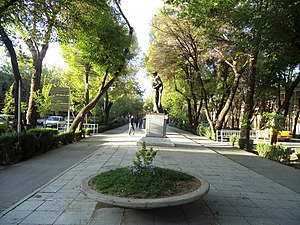Chahar Bagh Boulevard (Persian: چهارباغ, translation: Four Gardens) is a historical avenue in Isfahan constructed in the Safavid era of Iran. This histories street is very similar to the Champs-Élysées in Paris, which some visitors called the Champs-Élysées of Isfahan.


The avenue, historically, is the most famous in all of Persia. It connects the northern parts of the city to the southern sections and is about 6 kilometers long. On the east side of this street, there are the Hasht Behesht and Chehel Sotoun gardens.[1]
The avenue was named "Chahar Bagh" because Shah Abbas the Great had bought four vineyards in the city to secure the right-of-way.[2]
Shah Abbas I was the king who changed his capital from QazvintoEsfahan and decided to pour all the country's artistic wealth into that central spot which has been dubbed for centuries "Nisfi Jahan" or "Half the World". The chief architect of this task of urban planning was Shaykh Bahai (Baha' ad-Din al-'Amili),[3] who focused the programme on two key features of Shah Abbas's master plan: the Chahar Bagh avenue, flanked at either side by all the prominent institutions of the city, such as the residences of all foreign dignitaries, and the Naqsh-e Jahan Square ("Exemplar of the World").[4][5] After the opening of the enghelab metro station, chaharbagh abbasi,the middle section of avenue, was pedestrianized.[1]
| Native name | خيابان چهار باغ (Persian) |
|---|---|
| Length | 5.5 km (3.4 mi) |
| Location | Esfahan |
| North end | Shohada Squrare |
| South end | Azadi Squrare |
Chaharbagh Pa'in, or lower Chaharbagh, (Persian: چهارباغ پایین) is the northern section of the avenue. This part of Chaharbagh is from Shohada Square to Darvazeh Dowlat.
| Detailed characteristics | ||||||
|---|---|---|---|---|---|---|
| From North to South | ||||||
| Continues as: Kaveh Boulevard | ||||||
| Shohada Square |
Foruqi Street Ebn-e Sina Street Modares Street
| |||||
| Takhti Junction |
Masjed-e Seyyed Street Abdorrazaq Street
| |||||
| Imam Hosein Square |
Sepah Street Bagh Goldasteh Street Taleqani Street Babolrahmat Street
| |||||
| Continues as: Chaharbagh Abbasi | ||||||
| From South to North | ||||||
Chaharbagh Abbasi, (Persian: چهارباغ عباسی) is the middle section of the avenue. This part of Chaharbagh is from Darvazeh Dowlat to Northern 33 polatEnqelab Square.
| Detailed characteristics | ||||||
|---|---|---|---|---|---|---|
| From North to South | ||||||
| Continues as: Chaharbagh Pa'in | ||||||
| Imam Hosein Square |
Sepah Street Bagh Goldasteh Street Taleqani Street Babolrahmat Street
| |||||
| Sheykh Bahaei | ||||||
| Amadegah Street | ||||||
| Abbasabad Street | ||||||
| Enqelab Square |
Si-o-se Pol Motahari Street Kamaloddin Esmaeil Street
| |||||
| From South to North | ||||||
Chaharbagh Bala, or upper Chaharbagh, (Persian: چهارباغ بالا) is the southern section of the avenue. This part of Chaharbagh is from southern 33 poltoAzadi Square.
| Detailed characteristics | ||||||
|---|---|---|---|---|---|---|
| From North to South | ||||||
| Si-o-se Pol Mellat Street Ayenekhaneh Street | ||||||
| Si-o-se Pol Metro Station | ||||||
| Nazar Junction |
Nazar Street Mir Fendereski Street | |||||
| Shari'ati Metro Station | ||||||
| Shari'ati Street Nikbakht Street | ||||||
| Azadi Metro Station | ||||||
| Azadi Square |
Azadegan Boulevard Daneshgah Boulevard | |||||
| Continues as: Hezar Jarib Boulevard | ||||||
| From South to North | ||||||
32°39′11″N 51°40′07″E / 32.65306°N 51.66861°E / 32.65306; 51.66861